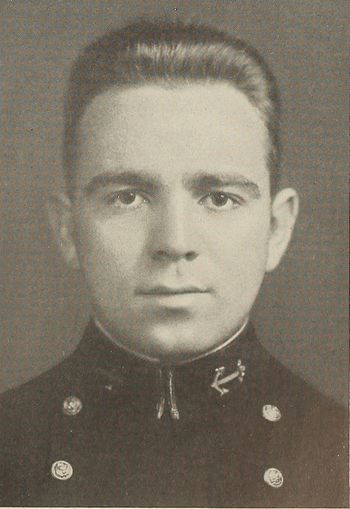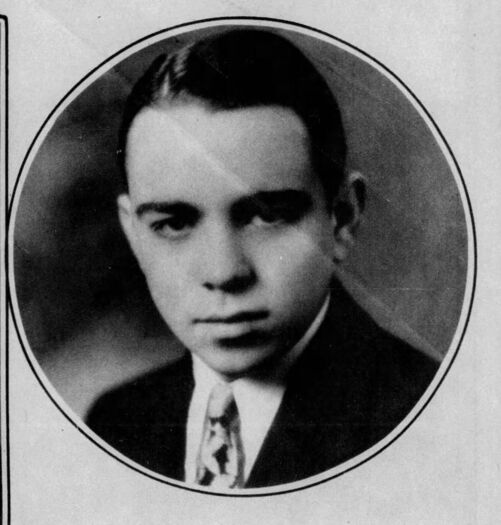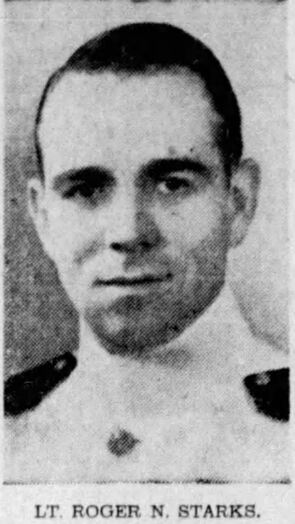ROGER N. STARKS, LT, USN
Roger Starks '38
Lucky Bag
From the 1938 Lucky Bag:
ROGER NORTON STARKS
Hartford, Connecticut
Jo-jo
From up in Yankeeland this gentleman came to us, small in stature but ready for and eagerly looking forward to a salty career in Uncle Sam's Navy. By nature, a determined fighter, Plebe year found him in the gym putting on the gloves with the best of them. Characterized inwardly by an underlying seriousness and idealism and outwardly by an indefatigable industry, he has emerged "the tops" in all the academics. His gracious manner has made him many friends because, whether it be to help a classmate pull sat or to lend him some money to drag on, Roger is more than willing. His three greatest ambitions right now are to finish the model ship he has begun, to collect all the stamps he can from British Colonies, and to become an officer in the Navy. Here's luck to you, Rog!
Class Football 4; Boxing 4; Gym 2; Stamp Club 2; M.P.O.

ROGER NORTON STARKS
Hartford, Connecticut
Jo-jo
From up in Yankeeland this gentleman came to us, small in stature but ready for and eagerly looking forward to a salty career in Uncle Sam's Navy. By nature, a determined fighter, Plebe year found him in the gym putting on the gloves with the best of them. Characterized inwardly by an underlying seriousness and idealism and outwardly by an indefatigable industry, he has emerged "the tops" in all the academics. His gracious manner has made him many friends because, whether it be to help a classmate pull sat or to lend him some money to drag on, Roger is more than willing. His three greatest ambitions right now are to finish the model ship he has begun, to collect all the stamps he can from British Colonies, and to become an officer in the Navy. Here's luck to you, Rog!
Class Football 4; Boxing 4; Gym 2; Stamp Club 2; M.P.O.
Career & Loss
Roger served as an ensign on the USS Perry then went to the New London submarine base for instruction. He was promoted to Lieutenant Junior Grade on September 30, 1940. He then joined the R-12 coastal defense submarine.
From Find A Grave:
Lieutenant Starks was killed when shortly after noon on 12 June 1943, R-12, while underway to conduct a torpedo practice approach, she sounded her last diving alarm. As R-12 completed preparations to dive, the forward battery compartment began to flood. The collision alarm was sounded and a report was made that the forward battery compartment was flooding. Orders were given to blow main ballast, but the sea was faster. In about 15 seconds, R-12 was lost. The commanding officer, one other officer, and three enlisted men were swept from the bridge as the boat sank and were rescued. Forty-two lives were lost. R-12 was stricken from the Naval Vessel Register on 6 July.
Other Information
From researcher Kathy Franz:
At Bulkeley High School, Roger was a member of the National Honor Society. He was appointed to the Naval Academy by Senator Augustine Lonergan. Roger graduated from submarine school in New London in 1940.
His parents were Mr. and Mrs. Samuel B. Starks. He was also survived by his sister, Elizabeth, and a brother Donald. Donald was an aviation ordnanceman second class and a member of Torpedo 35 based on an escort aircraft carrier in the Pacific. In September 1944, he was among 11 aerial gunners and radiomen who were commended by Rear Admiral G. D. Murray.
From the Hartford Courant on December 1, 1943:
Prophetic Inscription
Lieutenant Roger Starks, Bulkeley Graduate, Submarine Hero
To the Editor of the Courant:
On November 15, The Courant carried the account of a posthumous award made by the United States Navy to the mother of a gallant young officer who died in attempting to save the lives of his shipmates on the submarine with which he went down. . . .
Fellow crewmen were saved, but Lieutenant Starks, navigator, went down with his vessel.
There is a prelude to this heroic deed. It goes back ten years when Roger Starks was a senior at Bulkeley High School. At that time a half-dozen of his classmates were chosen to edit a class book. Among the various things they had to do was to cull quotations from different sources or to draw up original sayings and apply one to each member of the class, as a descriptive label of his outstanding trait of character. One day in the spring of 1933, these six high school boys and girls were seated around a table in their library engaged in matching descriptive label to class member.
Eventually they came to Roger Starks and, in thinking of a phrase or sentence which would describe most accurately the character and spirit of this young man who, ten years later, as navigator of a United States war vessel, was to sacrifice himself in the effort to save his shipmates, they wrote, as though it were with prophetic vision: – “The guard dies but never surrenders.” This is the inscription which underlines the picture of Roger Norton Starks in his high school class book.
Who knows in which direction these six words carried their greatest weight? Was it forward to June 1943, when the young lieutenant chose duty and death, serving as mere coincidental prophecy, or was it backward from ’43 to ’33 when, face with the supreme challenge of his life, he suddenly recalled the onerous assignment his classmates had placed upon him in his high school days – “The guard dies but never surrenders”?
This case is not unlike that of the Grecian mother who said to her son as she handed him his shield on his departure for battle, “Return with it or on it.” There is this difference however – in the case of the Grecian lad it was the individual who spoke to him, whereas in the case of Roger Starks, it was an entire generation whose voice he heeded.
Gustave A. Feingold, Hartford
His wife was listed as next of kin.
From Hall of Valor:
The President of the United States of America takes pride in presenting the Navy and Marine Corps Medal (Posthumously) to Lieutenant Roger Norton Starks (NSN: 0-81044), United States Navy, for heroic conduct when the U.S.S. R-12 (SS-89) was lost at sea, 12 June 1943. Lieutenant Starks, as Navigator and Second Officer, disregarded his personal safety and stood at his post directing efforts to save his ship. Although standing at the only possible exit, he made no effort to use it, although realizing that the uncontrolled flooding of the ship placed him in grave danger.
General Orders: Bureau of Naval Personnel Information Bulletin No. 321 (December 1943)
Action Date: June 12, 1943
Service: Navy
Rank: Lieutenant
Division: U.S.S. R-12 (SS-89)
Photographs
The "Register of Commissioned and Warrant Officers of the United States Navy and Marine Corps" was published annually from 1815 through at least the 1970s; it provided rank, command or station, and occasionally billet until the beginning of World War II when command/station was no longer included. Scanned copies were reviewed and data entered from the mid-1840s through 1922, when more-frequent Navy Directories were available.
The Navy Directory was a publication that provided information on the command, billet, and rank of every active and retired naval officer. Single editions have been found online from January 1915 and March 1918, and then from three to six editions per year from 1923 through 1940; the final edition is from April 1941.
The entries in both series of documents are sometimes cryptic and confusing. They are often inconsistent, even within an edition, with the name of commands; this is especially true for aviation squadrons in the 1920s and early 1930s.
Alumni listed at the same command may or may not have had significant interactions; they could have shared a stateroom or workspace, stood many hours of watch together… or, especially at the larger commands, they might not have known each other at all. The information provides the opportunity to draw connections that are otherwise invisible, though, and gives a fuller view of the professional experiences of these alumni in Memorial Hall.
July 1938
January 1939
June 1940
November 1940
April 1941

The "category" links below lead to lists of related Honorees; use them to explore further the service and sacrifice of alumni in Memorial Hall.

